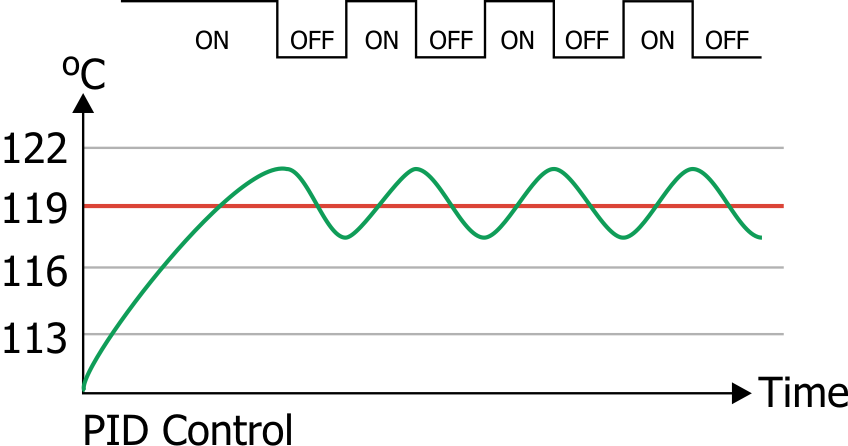"Let some steam off How your machine turns cold air into steam without using complicated magic."
In order to generate steam for your frothy coffees and hot water for your americano, we need to regulate the heating cycle of the water inside your machines main boiler.
As well as heat for steam and hot water, the temperature of the group head is also affected by the boiler temperature, so a trade off between the amount of steam you can generate, and the temperature of your coffee must be considered.
Most machines will run at the optimum performance with the pressure or the temperature set within the green zone on fig 1.0

Boiler pressure is mainly controlled using 2 types of control methods:
Diaphragm Switch - used to dominate boiler pressure control, but with price reductions in electronics PID is now taking over.

PID Control - (Proportional-Integral-Derivative) this method employs a temp sensor and solid state to control the element, the graph below shows the relevance between temperature and pressure.

Without doubt, PID is the preferred method. This offers very accurate boiler temperature control, which means more stable temperature across all machine functions, and the added benefit of reduced running cost by not wasting electricity.




This type of pressure switch functions using the build up of steam pressure within the main boiler. A feed is taken from the top of the boiler and fed to the pressure switch. As the steam builds up in pressure from the heating of the water inside the boiler, a diaphragm inside the switch then expands, at the operation point set by the pressure adjustment spring, the contacts open and power is removed from the element. The power cycle above is then repeated as steam or hot water is used from the boiler.
For: Cheap to implement and simple operation.
Against: Wide hysteresis of around 0.15 bar due to the type of components used in the construction.




Here we use a temperature sensor mounted towards the top of the boiler, the electrical signal from the sensor is then fed back to the machines control circuit which then supplies either a DC or an AC feed to operate a solid state relay that supplies the power going to the element.
The operating principles are in line with the diaphragm system above, but due to full electronic control we have a much tighter control of when power is supplied to the element and generally longer life for the element due to power only being supplied when the mains supply is at its zero point in the phase.
For: Accurate heat control, no moving parts, reduced running cost.
Against: Greater skill level in fault finding

a) Blockage in tube/fittings from the top of the boiler to the inlet on the pressure switch. Check all fittings and that steam can flow through to the pressure switch.
b) Check for faulty contacts on the pressure switch and that power is also being switched from the mains to the pressure switch contacts using a meter.
a) If the LED on the solid state is lit, is there mains power being switched through the output of the solid state to the element, if yes, check the element condition using your multi-meter.
b) Faulty temperature probe sending wrong reading to control circuit
a) Diaphragm pressure switch contacts welded together.
b) Faulty temperature probe sending wrong reading to control circuit.
